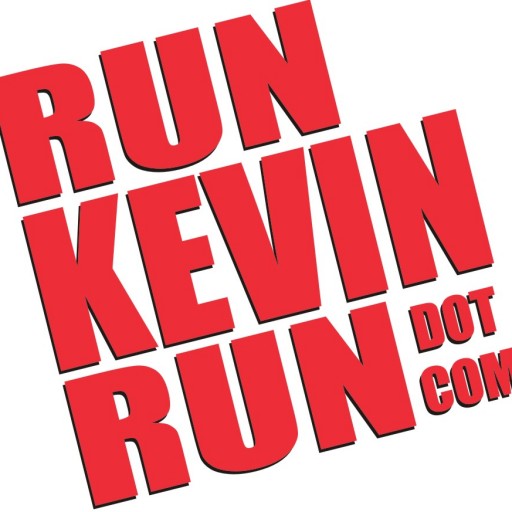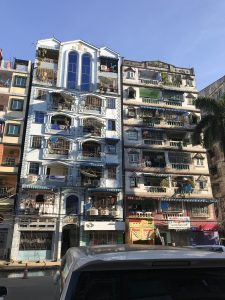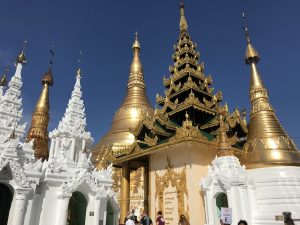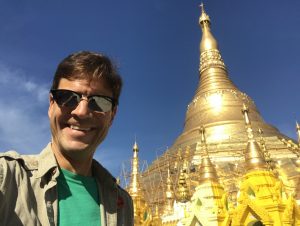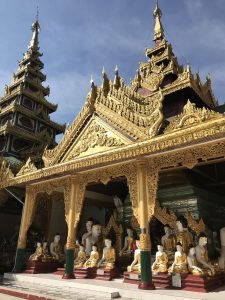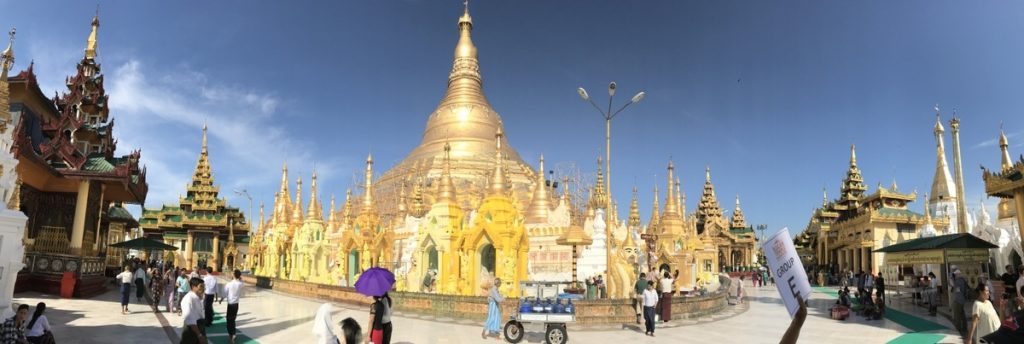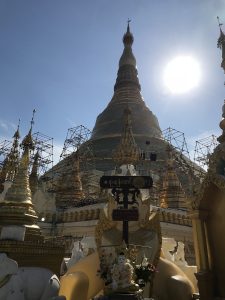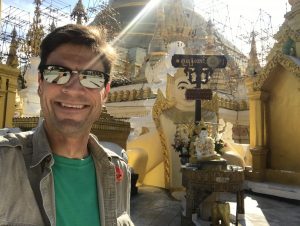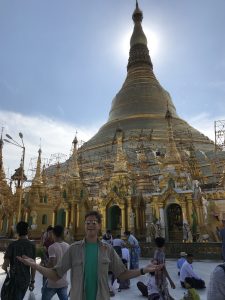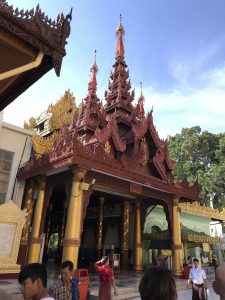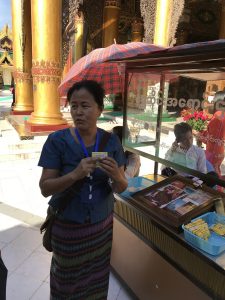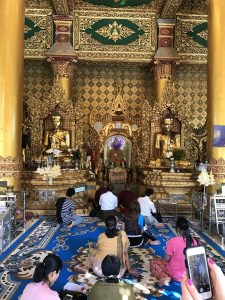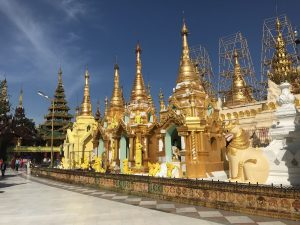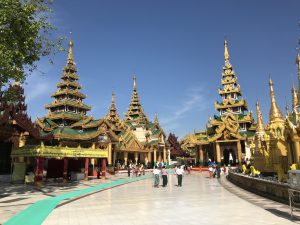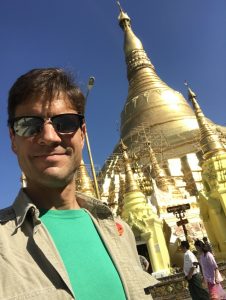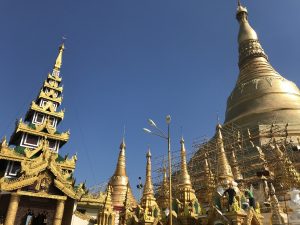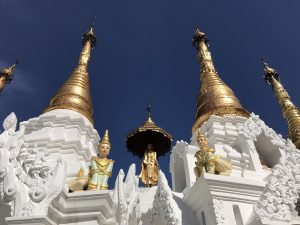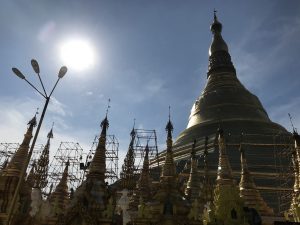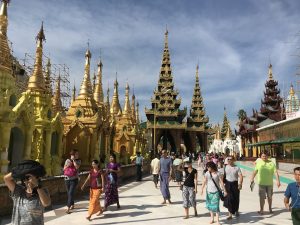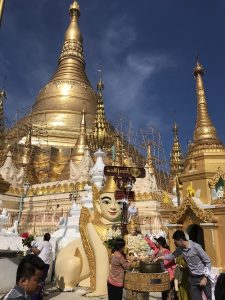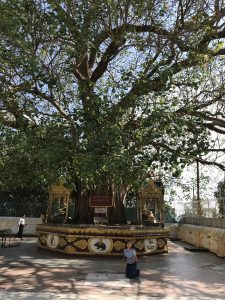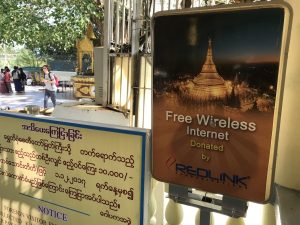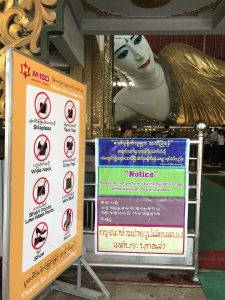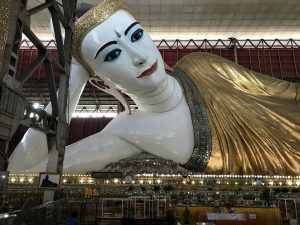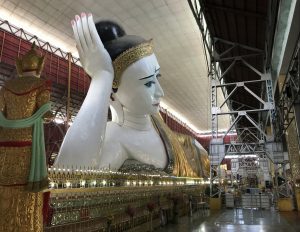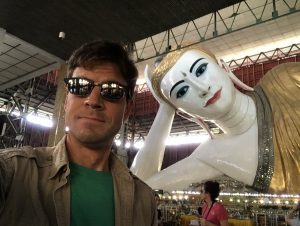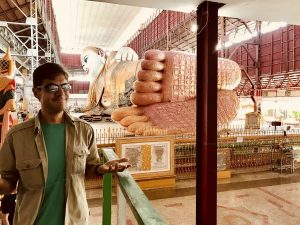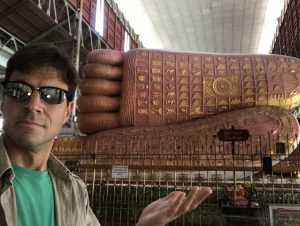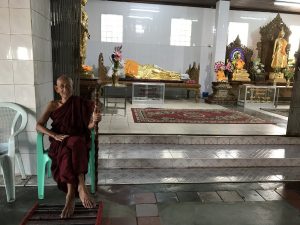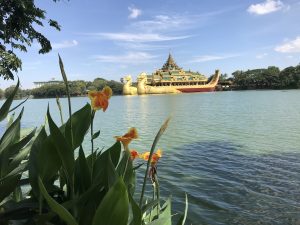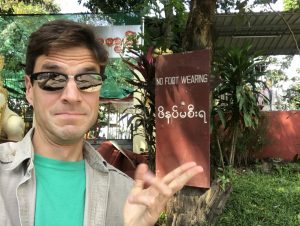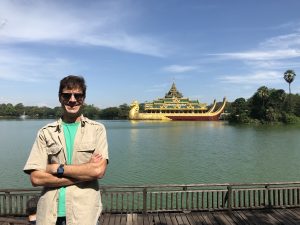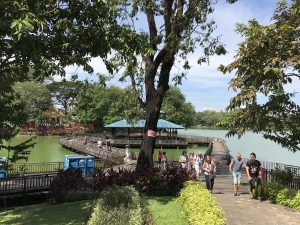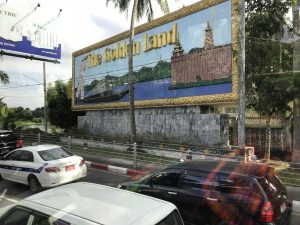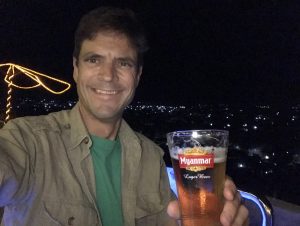My impressions of Yangon are that it’s a weathered, wilted place. Heat and humidity coupled with various chaotic leadership choices have left this city feeling like one can’t tell if the area is being demolished or under construction. Tara had a similar comment about Kunming and it’s an apt description of Burma’s former capital city. A military junta in 2005 moved the capital to Naypyidaw (literally translated as “New Capital”) 320 kilometers to the north. They moved all administrative and organizational elements, yet embassies and diplomats have remained in Yangon. In truth, Yangon remains Myanmar’s biggest city, a commercial hub thanks to history and the fact that it was two nearby seaports… which are really riverports but provide shipping opportunities aplenty.
This is a city and a nation in flux. There’s talk of plans by the government for improvements in infrastructure and education and while there’s a great deal of hope, the outcomes are far from certain.
Our tour leader from Albatros said it was fair game to ask about the civil war and reported ethnic cleansing in the North but to expect a standard vetted line in response. I haven’t had the courage to ask about it yet. I’m scared to hear what the standard vetted line might be.
***
Thus far throughout this trip, I’ve been just a few seconds slow or just a few seconds early in clicking my camera phone’s shutter. As a result, all of my photos are out-of-time and place. They don’t seem to capture the moment I had hoped. Occasionally I’ve seen other runners on the city tour showing off images they snapped and I think, “Wow – they really nailed it.” Looking at mine I can only think incredulously, “Wow… did I really just take a picture of that?!” I’m off and I want to blame jetlag but the reality is I’m just not a great photographer. That won’t preclude my uploading a bunch of subpar photos to the site but you’ve been forewarned. I’m trying to proverbially cull the wheat from the chaff but it’s more like a gluten free version of wheat – astro-wheat? Tofu-wheat? What’s a gluten free substitute? You get the idea.
***
I have a long notes file in my iPhone with various odds and ends of minutiae and trivia. But I suspect most of that is more for me than for an external audience. I’m therefore going to endeavor to keep that in mind and make this a bit more reader friendly. I have a tendency even in my best intentions to ramble incessantly and tangentially so we will see how I do.
Today felt more like a series of photo hops than sightseeing. Our local guide Sheila was certainly knowledgeable and like most Burmese I’ve encountered thus far super friendly and eager to help. After a typically robust breakfast we embarked on our large buses for a rolling city tour that was constrained by a charter flight to our next locale at 3:30 pm.
We were scheduled therefore to hit three main “must do”s in Yangon: a Giant Pagoda that serves as the de facto icon of Myanmar; a jumbo reclining Buddha; and one of two man made lakes (this third one is the place I ran around breaking the boardwalk the other day).
STOP 1 – 9 AM to 10 AM: SHWEDAGON PAGODA
Built some 2600 years ago, this 99 meter tall pagoda is purportedly built on eight hairs of the Buddha. I was hoping to see them a la Superman’s hair in The Quest for Peace (1987) but they’re apparently buried under all the gold, diamonds, jewels, and gold leaf decorations of this multilayered “onion” structure.
Surrounding the main pagoda are various shrines, prayer halls, and temples devoted to all things Buddhism. Four gates, oriented according to the compass offer entryway but there’s no significance to that other than for entry/exit. HOWEVER, the cardinal directions do play a significance when it comes to shrines devoted to the eight days of the Buddhist week. Yes, eight days a week. Wednesday is split into Wednesday proper (midnight to noon) and Rahu (noon to midnight). Each day has a special animal. For example, I was born in the afternoon on a Wednesday so I’m a Rahu baby and my spirit animal is a non-tusked elephant.
I know I said I wasn’t going to go into minute details but this is just a fun fact – when striking the bell at a Buddhist temple/shrine, it’s always done as an odd number – 3, 5, 7, 9, 11. Three times is the most typical and it’s a signal of “good deeds.” But it’s not boastful bragging; it’s designed to have the mind whispering good deeds and good fortune to the wind, sharing the good fortune with all creation. Or so I scribbled down when Sheila was telling us about it. As is often the case with tour guides, one never knows if it’s fact or just convenience to tell tourists; and moreso one never knows if the tourist understood what was being said in the first place.
Basically, take anything I say with not just a grain of salt but a veritable quarry of salt.
Oh, and good news — while you seek enlightenment, you are also able to surf the net:
Hey, Siri… how do I obtain nirvana?
***
STOP 2 – Chauk-htat-gyi Buddha Temple – A Jumbo “Reclining” Buddha – 10:20 – 10:40 AM.
Remember the salt caveat. My understanding is that there are two types of supine Buddhas in Myanmar – a relaxation position and a death position. The main differences are in the head and feet – a “death” Buddha is lying flat and the eyes may be closed, with feet in a straight orientation. A reclining Buddha meanwhile has a head propped on a pillow or his hand and the feet are straight and parallel.
In 1901, a patron built a giant Buddha but neglected to weatherproof it. The years took their toll and by the 1950s Buddha had fallen into disrepair. The government sought a coalition and in 1957 they demolished the old Buddha and rebuilt it across the street, this time in a large structure to protect it from the elements and ensure its longevity. The whole statue is concrete except for the eyes which are made of glass. The story goes that local Burmese artisans were unable to get the right “look” and so the glass, imported from Russia, was sent to Japan. But the Japanese couldn’t get it right either and finally it was brought back to a tiny glass factory in Yangon who were able to make it happen. They produced two sets of eyeballs and as the first set fell into place in the statue, the backup pair mysteriously shattered of their own accord. Or so the story goes. As he reclines now, this Buddha is the 2nd or 3rd largest Buddha in Myanmar. The largest is over 300 meters long; Chauk-htat-gyi is 65 meters long and 17 meters tall.
Unquestionably he’s a big Buddha.
And he has large shoes to fill.
Also, this monk charged me a dollar to take his photo. I really wanted to snap it while he was wearing his sunglasses. I warned you the photos weren’t great but when you pay a buck, sometimes that trumps editorial concerns:
***
STOP 3: KANDAWGYI LAKE and KARAWIK ROYAL BARGE – 11:20 – 11:40 AM.
In colonial Burma, the British used their two man-made lakes to provide drinking water to the town. But pollution has taken a toll and these days Yangon has to get its drinking water from 20 miles away. Farther afield, the drinking water isn’t great so we’ve been advised to stick with bottled water and avoid ice cubes and uncooked vegetables.
As I mentioned earlier, this is where I ran… er, walked cautiously… the other day. The Karawik Royal Barge is a concrete convention center/reception hall thing that LOOKS like a Royal Barge but is in fact not floating anywhere. It’s a Royal Barge tribute. And it looks like a bird.
The boardwalk remained as structurally unsound and non-non, non-non “strong bridge, Indy” as the day before.
***
I’ll skip the lunch discussion and our chartered flight to Mandalay for the time being. I’ll write more tomorrow about the imperial capital of Burmese Royalty before the British took over in the 19th century.
But before that, I thought I’d end with my butchered “Kevin style” pronunciation guide. Know that I’m far from a linguist.
An Idiot American’s Guide To Two Key Burmese Phrases:
Here’s what I scribbled down when Sheila tried to teach us important local language terms.
Hello – MING GALL LABBA.
Thank you – JAY ZOO BAY.
Ya know what? Maybe you should take this with a Utah-ian Great Salt Lake. I’m not sure I’m writing/saying it right.
I learned in Hungary that the fastest way to become fluent is to drink more. So, when in Myanmar, I guess I should drink, um, Myanmar…
